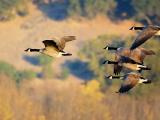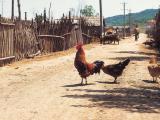Researchers from Germany's Friedrich Loeffler Institute today reported initial findings from H5N1 avian flu susceptibility studies in dairy cows, concluding that the cows are susceptible not only to the B3.13 subtype circulating in the United States but also to a virus isolated from a wild bird in Germany.
Results add another piece of the puzzle
The experiments, first reported in early May by Science, centered around infecting the udder through the teats in a high-containment lab setting. In a statement, the group said that, for both viruses, cows showed clear signs of disease such as a sharp drop in milk production, changes in milk consistency, and fever.
The researchers said the findings don't change their avian flu risk assessment, which they consider low, given that it already covers the chance of infections with other highly pathogenic H5 strains. "Nevertheless, increased vigilance is recommended, and HPAI H5 should also be considered in investigations, especially in the case of unclear and frequent cases of disease in dairy herds," the team wrote.
Direct infection of the udder is one of the transmission paths seen in US cattle, and extremely high viral levels have been found in the milk of infected cows. Recent tissue sample examination from US cows revealed that the H5N1 virus infects epithelial cells of mammary alveoli, prompting acute inflammation in the udder, which could explain the drop in milk production and high virus levels in milk.
It's not clear how the virus first jumped from wild birds to cows in the United States, but risk to ruminants has been present since the virus was first detected 27 years ago. The Loeffler Institute scientists referenced water buffalo in Asia that had contact with the feces of wild birds.
Kai Kupferschmidt, a writer from Science who has been tracking the experiments in cows, said on X today that the findings seem to answer one of the puzzling aspects of the H5N1 situation in US dairy cows: whether there is something special about B3.13 that led to the infections.
The Loeffler Institute researchers said they have tested about 1,400 serum samples from German cows from regions affected by avian flu, and so far no antibodies have been seen. The group also tested 350 tank milk samples from different regions, which were also negative.
More detections in US cows, mice, poultry
In other H5N1 developments, the US Department of Agriculture (USDA) Animal and Plant Health Inspection Service (APHIS) over the last few days has confirmed 14 more avian flu outbreaks on dairy farms, raising the total to 116. The latest detections are from Iowa (4), Idaho (3), Minnesota (3), Colorado (2), and Texas (2).
The virus continues to turn up on poultry farms, and APHIS confirmed two more outbreaks in Minnesota, both involving commercial turkey farms. One is located in Pipestone County and has 73,800 birds, and the other is a facility in Swift County that houses 114,600 birds. Both are in the southwestern part of the state.
Also, APHIS recently confirmed 19 more H5N1 detections in house mice, raising the total to 66. All are from New Mexico's Roosevelt County.



















